- 03 Feb 2025
- 9 Minutes to read
-
Print
-
DarkLight
-
PDF
Adding Group Data to a Report
- Updated on 03 Feb 2025
- 9 Minutes to read
-
Print
-
DarkLight
-
PDF
Overview
Group Data sections let you add details about a Group in one of your ThreatConnect® owners to a report. When adding Group Data sections to a report, you must first select the Group whose data you want to add to the report. Then you can select which Group Data sections to add to the report and customize them as desired.
Before You Start
User Roles
- To add Group Data sections to a report, your user account must have an Organization role of Standard User, Sharing User, Organization Administrator, or App Developer.
Adding a Group Data Section
Follow these steps to add a Group Data section to a report:
- Create a new report or open a saved report.
- If the Add Section drawer does not open automatically in the Report Editor, click + Add Section in the Report Editor toolbar. Alternatively, hover over an existing section in the report and click + Add Above or + Add Below.
- Select Group Data under the Intelligence Data section on the Add Section drawer.
- Select a Group from the Group dropdown on the Add Group Data menu.
- Select a Group Data section from the Add Group Data menu, and then configure the section.
Selecting a Group
After you select Group Data under the Intelligence Data section on the Add Section drawer, the Add Group Data menu will open. If you created a report from a Group’s Details screen or drawer, the Add Group Data menu will show that Group in the Group dropdown, as well as the Group Data sections you can add to the report (Figure 1).
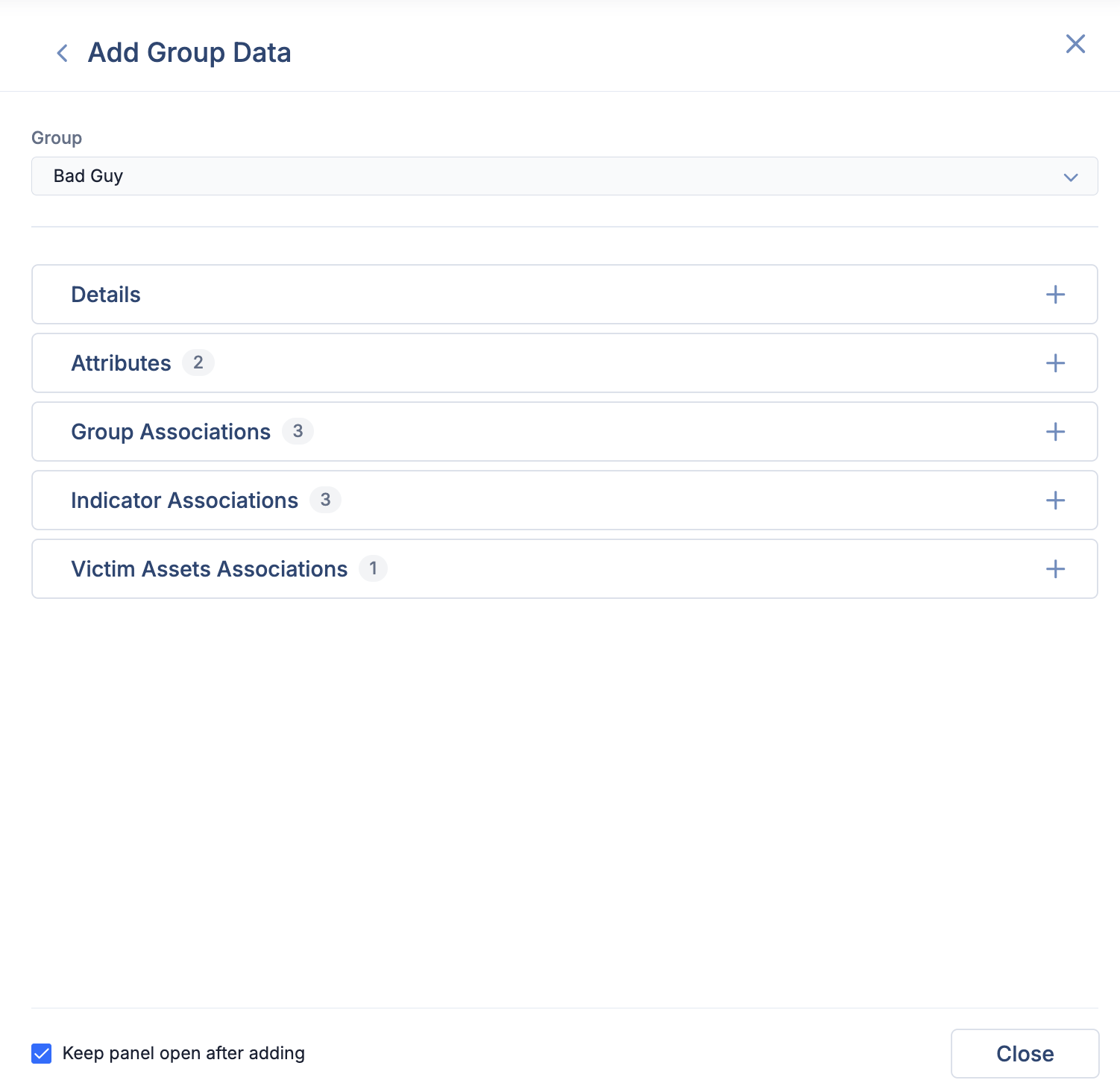
If you created a report from a Case or the Reporting screen, select View All Groups… from the Group dropdown on the Add Group Data menu. Then select the Group whose data you want to add to the report on the Select a Group window (Figure 2), which shows all Groups in your ThreatConnect owners.
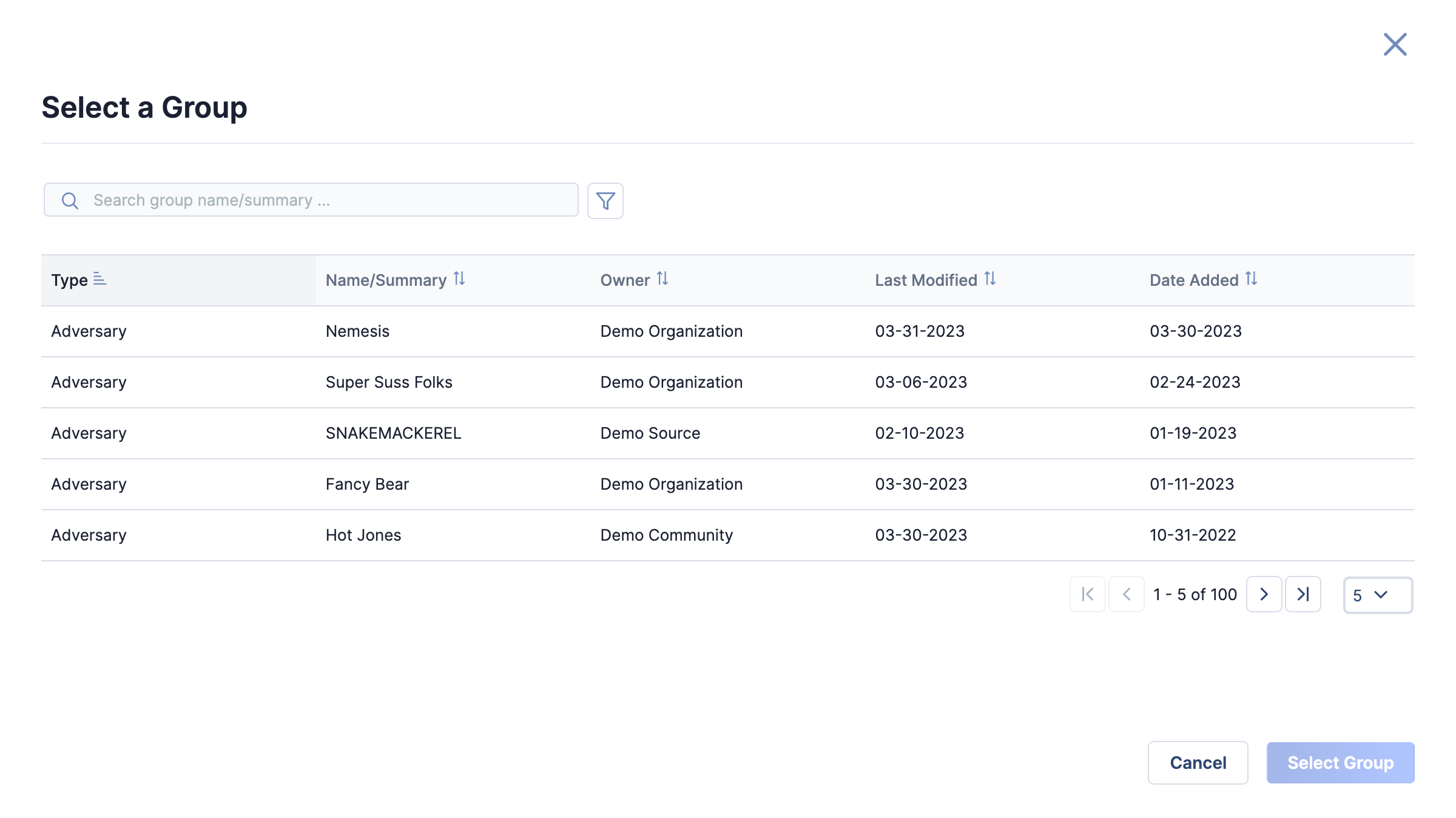
Group Data Sections
You can add any of the following Group Data sections to a report:
- Details
- Attributes
- Group Associations
- Indicator Associations
- Victim Assets Associations
- AI Generated Summary (available only for Report Groups in CAL ATL)
A Group Data section can display data from a single Group; however, you can return to the Add Section drawer to add multiple Group Data sections containing data from multiple Groups to a single report.
Details
The Details section can be used to display basic information about the selected Group. To add this section to a report, select Details from the Add Group Data menu (Figure 1). The Add Details menu will be displayed (Figure 3).
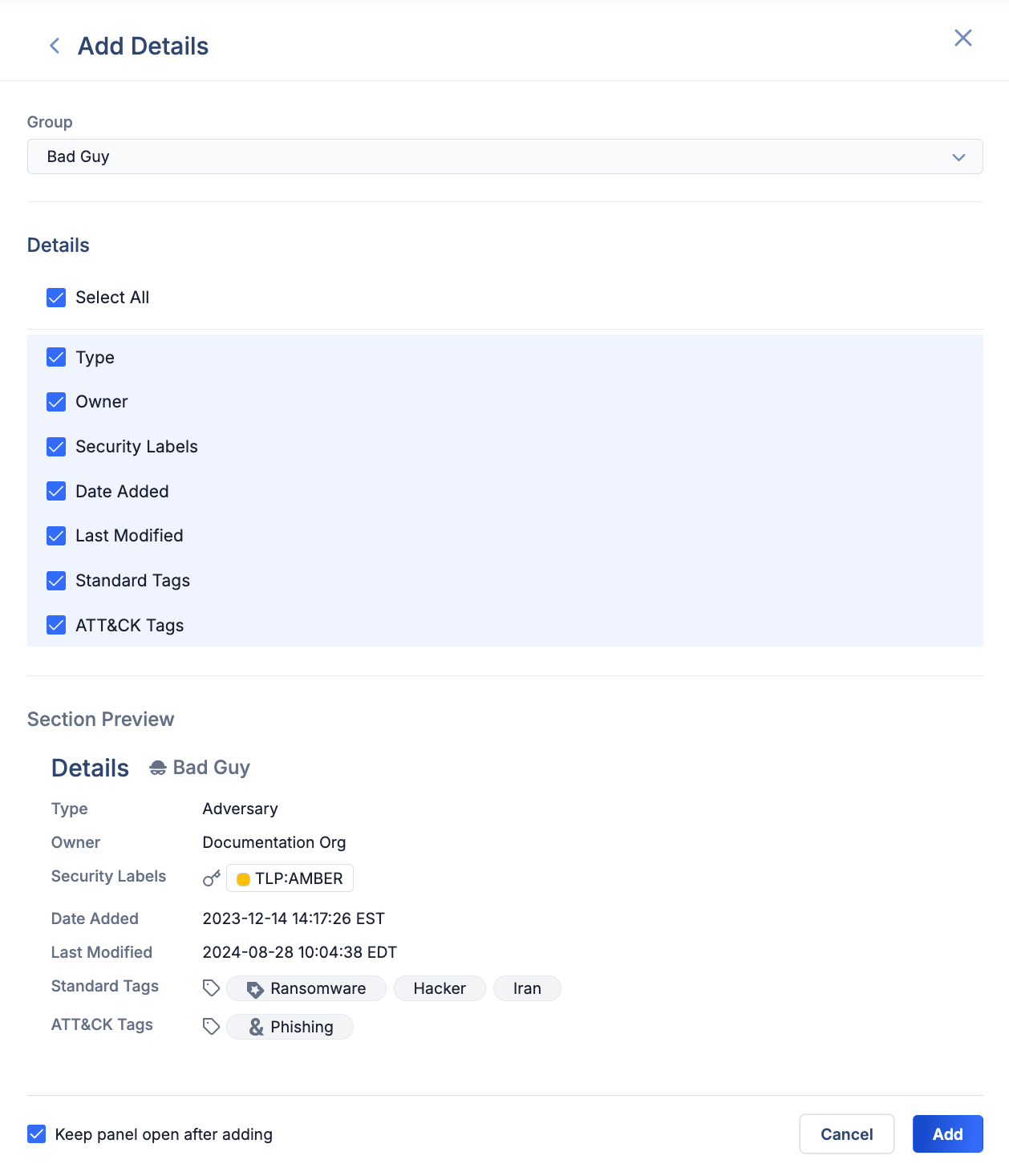
- Group: Use the dropdown to change the Group whose data will be used in the section, if desired.
- Details: To include all available Group data options in the Details section, select the Select All checkbox; otherwise, select the checkbox for each Group data option you want to include in the Details section. Available Group data options include the following:
- Name: The Group’s name.
- Type: The Group’s type.
- Owner: The Organization, Community, or Source to which the Group belongs.
- Security Label: The Security Label(s) applied to the Group.
- Date Added: The date and time when the Group was created.
- Last Modified: The date and time when the Group was last modified.
- Standard Tags: The standard Tag(s) applied to the Group.
- ATT&CK Tags: The ATT&CK® Tag(s) applied to the Group.
- Section Preview: This section displays a preview of the Details section that will be added to the report.
- Click Add to add the section to the report.
Attributes
The Attributes section can be used to display the following information about Attributes added to the selected Group:
- The Attribute’s type
- Security Labels applied to the Attribute
- The Attribute’s source
- The date when the Attribute was created
- The date when the Attribute was last modified
- The Attribute’s value (including tables and images added to its value)
To add this section to a report, select Attributes from the Add Group Data menu (Figure 1). The Add Attributes menu will be displayed (Figure 4).

- Group: Use the dropdown to change the Group whose data will be used in the section, if desired.
- Attributes: Select the checkbox for each Attribute to add to the report, or select the checkbox in the table’s header to select all Attributes on the current table page. To preview how an Attribute will look in the report, click
 to the left of the Attribute.NoteWhen you select one or more Attributes in the table, the Selected button at the top left of the table will show the current number of selected Attributes. To view only the Attributes currently selected in the table, click Selected.
to the left of the Attribute.NoteWhen you select one or more Attributes in the table, the Selected button at the top left of the table will show the current number of selected Attributes. To view only the Attributes currently selected in the table, click Selected. - Click Add to add a section to the report for each selected Attribute.
Group Associations
The Group Associations section can be used to display information about Groups associated to the selected Group in a tabular format. To add this section to a report, select Group Associations from the Add Group Data menu (Figure 1). The Add Group Associations menu will be displayed (Figure 5).

- Group: Use the dropdown to change the Group whose data will be used in the section, if desired.
- Filters: By default, Groups of all types belonging to any owner to which you have access will be displayed in the Group Associations table. If desired, use the following options in this section to filter associated Groups displayed in the table:
- Type: Select one or more Group types. Only Groups of the selected type(s) will be displayed in the table.
- Owner: Select one or more owners. Only Groups that belong to the selected owner(s) will be displayed in the table.
- Date Added: Click the from and to fields and use the date selectors to select the beginning and end of a date range, respectively. Only Groups that were created within the specified range will be displayed in the table.
- Last Modified: Click the from and to fields and use the date selectors to select the beginning and end of a date range, respectively. Only Groups that were last modified within the specified range will be displayed in the table.
- Table Settings: Use the following options in this section to customize the display settings for the Group Associations table:
- Table Columns: By default, all available table columns will be displayed in the table. To prevent a table column from being displayed in the table, clear the checkbox corresponding to its name.
- Table Cutoff: Enter the maximum number of associated Groups to display in the table. The minimum value you can enter is 5, and the maximum value you can enter is 80.
- Sort By: Select the table column by which to sort associated Groups in the table. You can sort associated Groups by any table column, including those not displayed in the table.
- Ascending/Descending: Select whether to sort associated Groups in ascending or descending order. The sort order will correspond to the column by which the table is sorted.
- Section Preview: This section displays a preview of the Group Associations table that will be added to the report.
- Click Add to add the section to the report.
Indicator Associations
The Indicator Associations section can be used to display information about Indicators associated to the selected Group in a tabular format. To add this section to a report, select Indicator Associations from the Add Group Data menu (Figure 1). The Add Indicator Associations menu will be displayed (Figure 6).
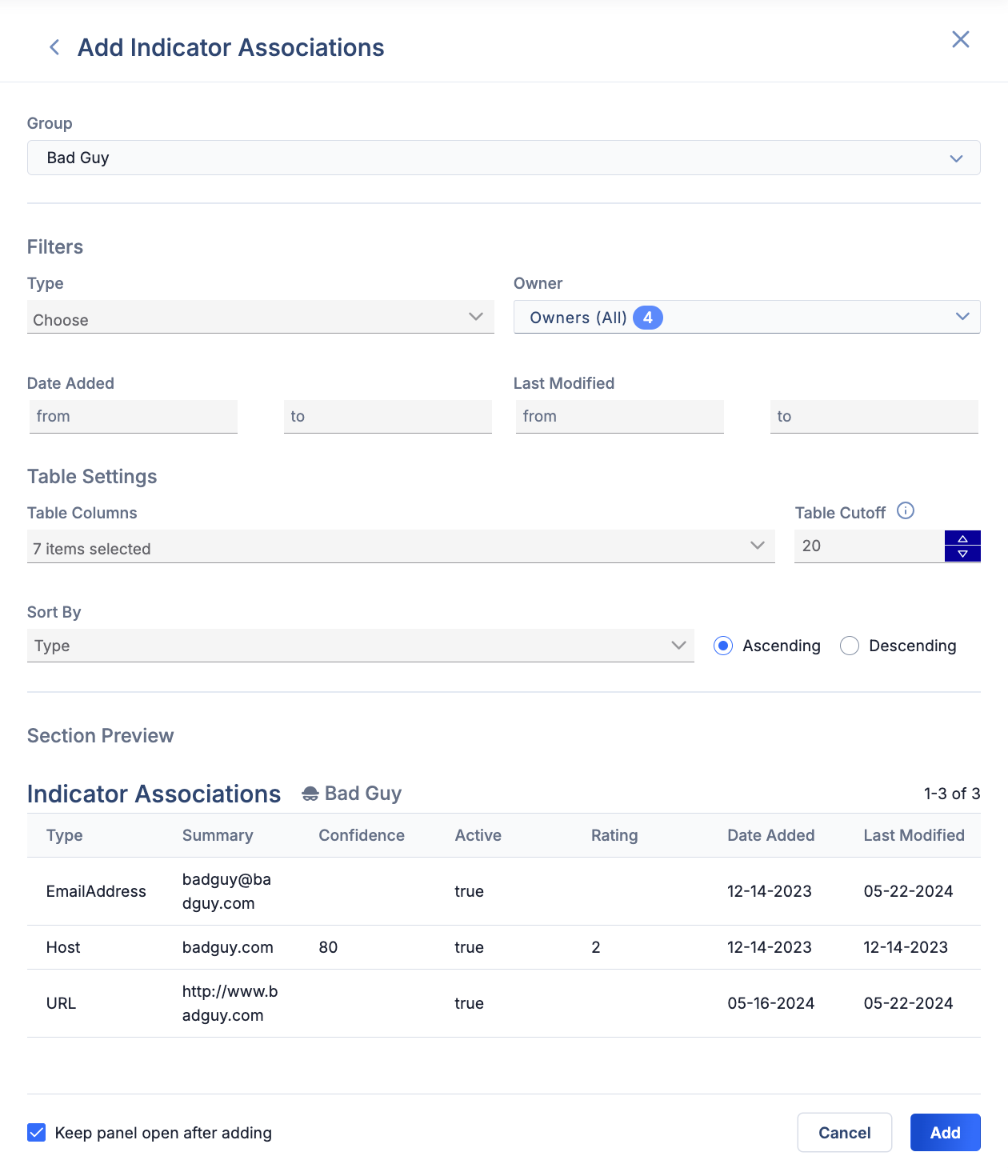
- Group: Use the dropdown to change the Group whose data will be used in the section, if desired.
- Filters: By default, Indicators of all types belonging to any owner to which you have access will be displayed in the Indicator Associations table. If desired, use the following options to filter associated Indicators displayed in the table:
- Type: Select one or more Indicator types. Only Indicators of the selected type(s) will be displayed in the table.
- Owner: Select one or more owners. Only Indicators that belong to the selected owner(s) will be displayed in the table.
- Date Added: Click the from and to fields and use the date selectors to select the beginning and end of a date range, respectively. Only Indicators that were created within the specified range will be displayed in the table.
- Last Modified: Click the from and to fields and use the date selectors to select the beginning and end of a date range, respectively. Only Indicators that were last modified within the specified range will be displayed in the table.
- Table Settings: Use the following options in this section to customize the display settings for the Indicator Associations table:
- Table Columns: By default, all available table columns will be displayed in the table. To prevent a table column from being displayed in the table, clear the checkbox corresponding to its name.
- Table Cutoff: Enter the maximum number of associated Indicators to display in the table. The minimum value you can enter is 5, and the maximum value you can enter is 80.
- Sort By: Select the table column by which to sort associated Indicators in the table. You can sort associated Indicators by any table column, including those not displayed in the table.
- Ascending/Descending: Select whether to sort associated Indicators in ascending or descending order. The sort order will correspond to the column by which the table is sorted.
- Section Preview: This section displays a preview of the Indicator Associations table that will be added to the report.
- Click Add to add the section to the report.
Victim Assets Associations
The Victim Assets Associations section can be used to display information about Victim Assets associated to the selected Group in a tabular format. To add this section to a report, select Victim Assets Associations from the Add Group Data menu (Figure 1). The Add Victim Assets Associations menu will be displayed (Figure 7).
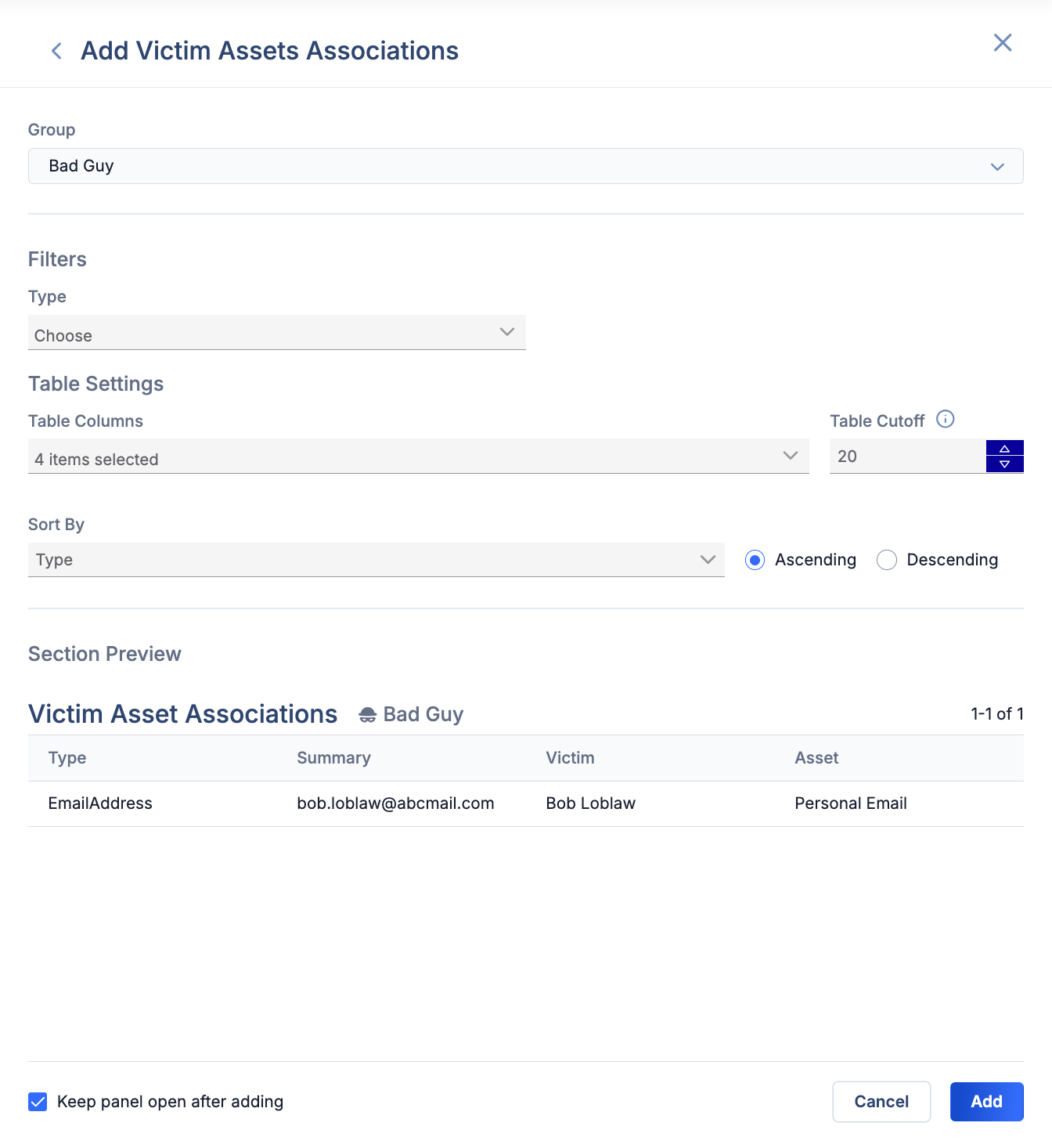
- Group: Use the dropdown to change the Group whose data will be used in the section, if desired.
- Type: By default, Victim Assets of all types will be displayed in the Victim Assets Associations table. If desired, select one or more Victim Asset types. Only associated Victim Assets of the selected type(s) will be displayed in the table.
- Table Settings: Use the following options in this section to customize the display settings for the Victim Asset Associations table:
- Table Columns: By default, all available table columns will be displayed in the table. To prevent a table column from being displayed in the table, clear the checkbox corresponding to its name.
- Table Cutoff: Enter the maximum number of associated Victim Assets to display in the table. The minimum value you can enter is 5, and the maximum value you can enter is 80.
- Sort By: Select the table column by which to sort associated Victim Assets in the table. You can sort associated Victim Assets by any table column, including those you chose not to display in the table.
- Ascending/Descending: Select whether to sort associated Victim Assets in ascending or descending order. The sort order will correspond to the column by which the table is sorted.
- Section Preview: This section displays a preview of the Victim Assets Associations table that will be added to the report.
- Click Add to add the section to the report.
AI Generated Summary
The AI Generated Summary section can be used to display an artificial intelligence–generated summary of a Report Group in the CAL Automated Threat Library Source. To add this section to a report, select AI Generated Summary from the Add Group Data menu (Figure 1). An AI Generated Summary section will be added to the report automatically, as there is no configuration required for this section.
ThreatConnect® is a registered trademark, and CAL™ is a trademark, of ThreatConnect, Inc.
MITRE ATT&CK® and ATT&CK® are registered trademarks of The MITRE Corporation.
20144-09 v.04.B


